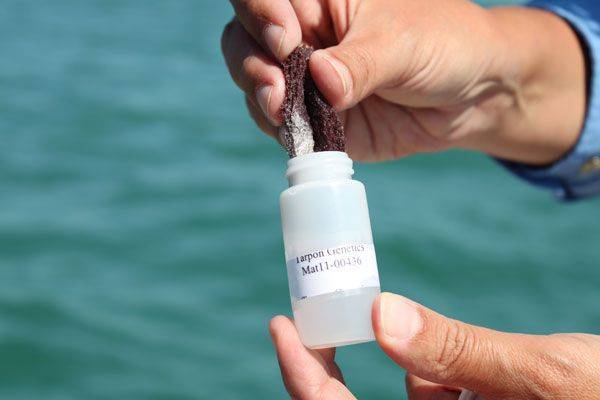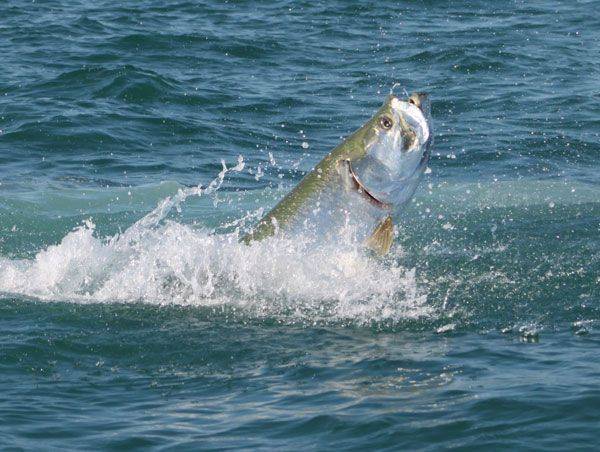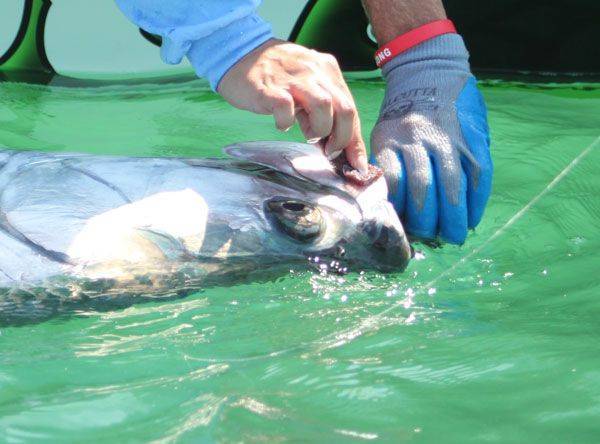by Kathy Guindon, Ph.D. and Kevin Baxter
[dropcap]F[/dropcap]ish tagging and marking is a common tool in fishery science and is used to obtain important information about a fish species. Scientists can learn fish swimming speeds, spawning habitats, reproductive biology, survival rates, growth rates, stock identification, abundance and more. While tarpon are a popular sport fish, relatively little of this information is known about the species. Recent advances in science have allowed biologists with the Florida Fish and Wildlife Conservation Commission (FWC) and Mote Marine Laboratory to work together with anglers to track individual tarpon. The Tarpon Genetic Recapture Study (TGRS) uses each tarpon’s unique fingerprint found in its DNA as a biological tag. With the help of volunteer anglers who submit DNA samples, the study has catalogued DNA from more than 22,000 tarpon samples since the pilot study in 2005.
Each time a tarpon is sampled it’s considered an event, and a fish that has been sampled more than once is considered a recapture. To collect genetic samples from tarpon, volunteer anglers use a small piece of abrasive sponge (part of a free DNA kit provided to interested participants) to scrape some skin cells from the outer jaw of the tarpon. Anglers then submit these samples to the Fish and Wildlife Research Institute with the accompanying catch information (time, date, location). Once researchers receive these samples, geneticists extract DNA from the skin cells. This DNA identification can determine recapture rates of tarpon in the fishery. These recaptures provide evidence of long-term survival from fishing events and insight into the seasonal and regional movements of individual fish. By evaluating capture events of sampled tarpon through time biologists can begin to assess the connectivity of tarpon between different bodies of Florida waters.
As of May 1, 2014, biologists have identified 217 recaptured tarpon through DNA sequencing performed in the FWRI onsite genetics lab. Biologists classify recaptures into categories according to distance and time between the initial event and subsequent events. The study so far has shown that there is an exchange of tarpon movements between neighboring estuaries such as Tampa Bay and Charlotte Harbor, and between regions of the Gulf coast and the Florida Keys. Regional movements are defined as those with 100 miles or more between the capture locations. For example, one tarpon exhibited a regional movement from Sarasota beaches to Islamorada in less than three weeks. The longest regional movement recorded through recaptures from this study was approximately 280 miles, from Apalachicola to Captiva. Yet other tarpon travels are not as vast, as exemplified by a tarpon caught multiple times within the same east coast river system.
Biologists also investigate tarpon recapture events to learn more about seasonal habitats and movement patterns. By evaluating the dates of the DNA sampling events, they can classify recaptures as either during spawning season, which is April to July, or during the off season, August to March. The DNA samples provide evidence that adult tarpon caught along the central and southwest coast return to the same locations between subsequent spawning seasons.
There are more than 2,500 anglers in the study’s database and over 400 return samples in any given year. The study depends on how thorough and accurate the anglers are while completing the data slips from the DNA kits. There is much more to learn about this magnificent species and with the aid of the angling public and DNA tagging methods, many of these biological secrets should begin to unfold. However, north Florida needs a boost in tarpon DNA sample submissions. In order to get the best understanding of the fishery statewide, we need angler support and participation in north Florida counties. For this reason the Florida Guides Association (FGA) is hosting a regional angler incentive in 2014, The FGA/FWC Spirit of Tarpon Sampling Challenge.
For this final year of the study and for the Sampling Challenge, anglers are asked to sample tarpon longer than 30 inches. The study already has thousands of samples from south Florida but very few from the Nature Coast and Panhandle counties of the Gulf coast and counties along the middle and northern Atlantic Coast. The angler who returns the most tarpon DNA samples from the northern Gulf and Atlantic coasts during this calendar year will each receive a prize packet compiled by the Florida Guides Association and will include a framed certificate signed by the president of the FGA and the chairman of the FWC. For more information on the challenge please contact the secretary/treasurer Captain Charlie Phillips at www.florida-guides.com.
All anglers remain an active part of the study even after their samples are submitted. Anglers who recapture a fish will receive a letter that provides the data from each event. They will also receive a map showing each capture location as it was entered on their data slip. This gives the angler a snapshot in time of their tarpon’s movements. In addition, everyone who participates in the study receives an annual newsletter discussing the latest developments of the project.
To obtain a DNA sampling kit, call the toll-free number, 1-800-367-4461, email TarponGenetics@MyFWC.com, or visit one of over 200 participating retailers around the state. Kits are free to tarpon anglers and have no expiration date. The DNA samples require no refrigeration. To read more about the Tarpon Genetic Recapture Study or to watch an educational video, visit http://myfwc.com/research/saltwater/tarpon/genetics. Even if you only take one tarpon DNA sample all year, it will be a very important contribution to the study.




